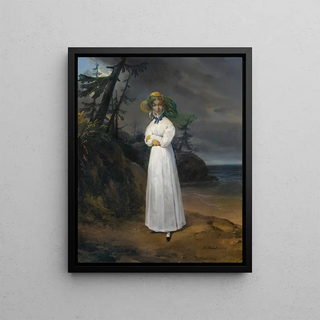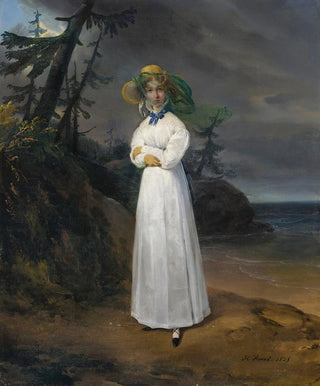Art print | Portrait of the widow Countess Jean Henri Louis Greffulhe and Marie Françoise Célestine de Vintimille du Luc later Countess Philippe Paul de Ségur 1787–1862 in a landscape - Horace Vernet


View from behind

Frame (optional)
The portrait of the widow countess Jean Henri Louis Greffulhe and Marie Françoise Célestine de Vintimille du Luc, later countess Philippe Paul de Ségur, 1787–1862, set in a landscape – Horace Vernet – Captivating introduction
The portrait of the widow countess Jean Henri Louis Greffulhe and Marie Françoise Célestine de Vintimille du Luc, created by Horace Vernet, is a work that transcends the simple frame of painting to establish itself as a living testament to 19th-century French aristocracy. Through this art print, viewers are invited to immerse themselves in a universe where elegance and refinement intertwine with the surrounding nature. Vernet, master of historical scenes and portraits, succeeds in capturing not only the appearance of his subjects but also their essence, their history, and their place in the world. This painting is a true journey through time, where each brushstroke tells a story, and every detail is loaded with meaning.
Style and uniqueness of the work
Vernet's style is characterized by meticulous attention to detail and mastery of colors that impart an almost tangible atmosphere to his works. In this portrait, the composition is carefully balanced, with the widow countess standing with natural grace, while the landscape in the background evokes a serenity that contrasts with the weight of her status. The shades of green and blue in the natural setting harmonize beautifully with the rich tones of the countess's clothing, creating a symbiosis between the subject and her environment. The subtly manipulated light highlights the delicate features of the countess's face, revealing an emotional depth that captures the viewer's attention. This art print does not merely depict an aristocratic figure; it also evokes universal themes such as loss, memory, and the passage of time, making the work timeless.
The artist and his influence
Horace Vernet is an emblematic figure of French Romanticism, whose work has established itself both through its technique and thematic choices. Born in 1789 into an artistic family, Vernet was influenced by the artistic movements of his time.

Matte finish

View from behind

Frame (optional)
The portrait of the widow countess Jean Henri Louis Greffulhe and Marie Françoise Célestine de Vintimille du Luc, later countess Philippe Paul de Ségur, 1787–1862, set in a landscape – Horace Vernet – Captivating introduction
The portrait of the widow countess Jean Henri Louis Greffulhe and Marie Françoise Célestine de Vintimille du Luc, created by Horace Vernet, is a work that transcends the simple frame of painting to establish itself as a living testament to 19th-century French aristocracy. Through this art print, viewers are invited to immerse themselves in a universe where elegance and refinement intertwine with the surrounding nature. Vernet, master of historical scenes and portraits, succeeds in capturing not only the appearance of his subjects but also their essence, their history, and their place in the world. This painting is a true journey through time, where each brushstroke tells a story, and every detail is loaded with meaning.
Style and uniqueness of the work
Vernet's style is characterized by meticulous attention to detail and mastery of colors that impart an almost tangible atmosphere to his works. In this portrait, the composition is carefully balanced, with the widow countess standing with natural grace, while the landscape in the background evokes a serenity that contrasts with the weight of her status. The shades of green and blue in the natural setting harmonize beautifully with the rich tones of the countess's clothing, creating a symbiosis between the subject and her environment. The subtly manipulated light highlights the delicate features of the countess's face, revealing an emotional depth that captures the viewer's attention. This art print does not merely depict an aristocratic figure; it also evokes universal themes such as loss, memory, and the passage of time, making the work timeless.
The artist and his influence
Horace Vernet is an emblematic figure of French Romanticism, whose work has established itself both through its technique and thematic choices. Born in 1789 into an artistic family, Vernet was influenced by the artistic movements of his time.






